Tuesday, May 27, 2008
Monday, May 26, 2008
Transit Space Race 202: Who's On Top?
The leaders are far ahead of the other cities, many of which are either just building as funds come available or still in the initial stage of denial. That doesn't mean there's not time to catch up, but these leading cities are still the reason I started covering the space race. Because they were accelerating expansion far beyond the line at a time doctrine and capturing the hope that things can change and people are ready for it.
Denver - Fastracks is still the granddaddy of expansion. The West Corridor has begun construction and the 119 new miles of rail are expected to be completed by 2016. That seems so soon, so awesomely soon in fact that folks are starting to look at the next round of possibilities.
Houston - While not as publicized as much as the Fastracks expansion, the Metro Solutions expansion was actually voted on before Fastracks. However it wasn't seen as such a big deal until it was looked at in the context of all these other expansions. It's more of a central city circulation system but works with existing HOV bus lanes to allow people in the dense core of Houston to get around. I wonder what the weighted Density is inside the loop. AC?
Salt Lake City - Fast on the heels of Denver and Houston, Salt Lake City passed a sales tax measure to expand on the initial success of their first line, which opened in 1999. The expansion is called Front Lines and will build 70 miles worth of rail in 7 years.
Minneapolis - While there isn't a plan in place for expansion like the other cities, there are lines that will get the money when it comes. The DFL party in Minnesota passed a sales tax expansion for capital transit expansion and overrode a veto by vice presidential hopeful Gov. Pawlenty. This doesn't include a possible center city streetcar network under discussion.
These four cities are in the fast lane. Other cities are building network expansions but at a slower pace. Charlotte passed a half cent sales tax in 1998 but is expanding their 5 line system slowly. There are considerations for further tax increases for expansion in other cities as well including Seattle, Phoenix, Los Angeles, Dallas and Sacramento among others. We will be watching as gas prices goes up and the call for expansion increases. It wouldn't hurt either to have a more friendly administration in the White House.
Oh, and let's not forget the godfather, Portland. 4 lines and a streetcar exist. Two lines are under construction while three other lines are in waiting with a center city streetcar network looking more likely. They are still the leaders and set the standard but the next generation is gaining.
Friday, May 2, 2008
Kenworthy Speaks
1. LRT(Tram) Patronage in Europe has been increasing while bus ridership falls.
This is interesting to me because unlike the United States, Europe has kept a good amount of its tram systems. In many large cities, they are still networked to go a lot of places.
According to Jeff, in Europe, over a period of 10 years, Light Rail Transit (LRT) patronage rose 20.3% while bus patronage fell 5.6%. His implication is that people, the masses, simply and unequivocally prefer rail over bus. And surprisingly, it’s actually what are commonly considered the disadvantages of rail that turn out to be it’s advantages over bus transit in encouraging use. The high cost and inflexibility of rail creates a permanence that people prefer over the impermanent and unreliable nature of bus transit.2. Rail Focuses Development, Buses Follow it
Another polished gem Jeff provided us with was the idea that rail systems “focus” a city and development while bus systems simply “follow” development. So buses, because of their impermanence and reliance on auto roads, must heed to the “predict and provide” game and attempt to follow wherever development may randomly occur. Rail on the other hand spurs and centralizes development, creating a sense of permanence not found in no rail cities. Rail and streets renaissances go hand in hand.I've said this a few times before. Rail has the power if harnessed to focus development unlike buses that just respond to it. But it's not going to just happen. There need to be plans and policies in place to do it right. In the comments below Fred's post, a discussion started on San Jose. This is the perfect example of just saying that light rail is going to do all the work. I posted a while ago on employment sprawl. Well here again is an aerial of San Jose's system by all the tech jobs, something to not emulate.

Here is the Pearl District, which used to be a rail yard and was helped by the plans and policies of the PDC and the streetcar

Update: ABC in the comments asked that we use a more suburban area to show what's possible instead of an urban area. In the situation like San Jose above with 3 -5 story office buildings I think it's perfectly ok to expect a street grid like the Pearl Districts, there was a thought that it was the Pearl was predestined to turn out that way. Before the development agreement it was supposed to be tops 15 units an acre and the developer had thought about doing townhomes. Here is what it looked like in 1996.
 But as suburban examples go, here is another from Portland with single family homes in a grid South of Orenco Station.
But as suburban examples go, here is another from Portland with single family homes in a grid South of Orenco Station.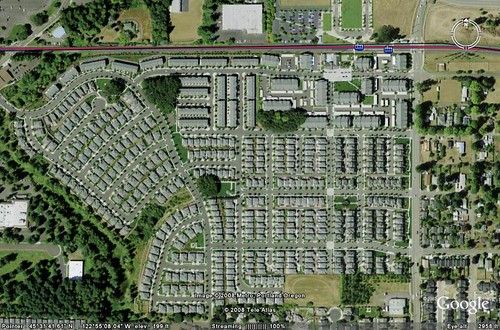
Downtown Plano trying to reintroduce Urbanism
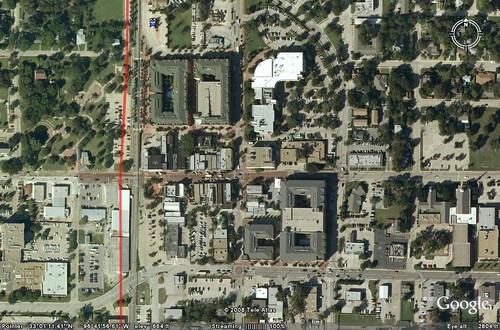
And a Heavy Rail Subway example, Rosslyn Ballston on the Metro Orange Line. I've discussed this before but this used to be a strip suburban corridor. These things take time, this has been over 30 years.

Sunday, April 6, 2008
Streetcars: Getting Out of Our Silos
When we look at streetcars from a purely transportation standpoint, we are missing the point. We are creating silos in which to put different aspects of the city. Transportation here, land use here, city fiscal responsibility here, and the environment here.
If we are to look at the overall benefits and needs, we see that there is a great benefit to streetcars when they are appropriate which I believe they were in Portland and Seattle given the goals of these lines. The goals implicitly or explicitly were to tie downtown to a new neighborhood that would boost walkability and livability in the city for more people. There is an important lesson for how cities benefit from transportation such as the streetcar.
1. The Corridor vs. Node
Streetcars are not meant to be rapid transit but rather pedestrian accelerators within districts and areas just outside of town. If you think that streetcars are the solution to everything, you are wrong. A system is needed but how the technology influences land use is important to the decision. Given that the streetcar is pedestrian scaled, it creates a corridor of pedestrian oriented development. This is why many of the first ring suburbs have commercial strips that were once served by streetcars. It's also why many of the former interurban lines formed small towns around the station, just like light rail creates a node of development today. Two different transit modes, two different purposes.
2. Streetcar Corridors Create More Density/Value
More density means more rooftops means more close retail means more walking. This is important because when we build new neighborhoods we want people not to do the same things they do in sprawl. The key to the streetcar is increasing the envelope for density on a corridor. In fact the streetcar in Portland pushed developers to get closer to their density maximums closer to the line. 90% of the envelope was filled one block from the line. 75% two blocks and further down. Seattle is doing the same thing. Building at higher densities that would usually be built because of developer confidence in the future of the streetcar.
But why is this important? Well it means that over the long term, that piece of land will create more tax revenue than whatever dreck was built next to the bus line. So when we look at the streetcar funding issue versus the bus, how much more value was created for the community? What is the tax creation of a 10 story building over 100 years versus a 5 story building? So in the whole scheme of things, the bus is a cheap alternative that in the end costs the city more. We need to get out of that silo.
3. It Creates the Pedestrian Experience
Part of the reason for building the streetcar and creating the density is creating a good pedestrian and street environment. Who wants a bus running by your dinner? Your coffee?

But also, the creation of a pedestrian environment and pedestrian accelerators increased the area folks are willing to walk. And the creation of more of these neighborhoods on a corridor by streetcars is important because this increased walking has been shown to reduce VMT. In fact the 7,200 housing units along the Portland Streetcar line have been estimated to reduce VMT by 53 million miles a year. Thats nothing to sneeze at and will be something that decreases greenhouse gases. But all of this is not attributable to the streetcar, but to the creation of a walkable environment from the densities and streetscapes. Developers are more willing to create these densities and places with the streetcar instead of a bus.
As I have said before, its not always about speed. Creating an environment for pedestrians means also a slower environment, a safer environment. While 43,000 a year die on the highways, I heard this weekend from Rick Gustafson of Portland Streetcar Inc that the Streetcar has had accidents, but no one has been seriously injured.
So while a bus might be more flexible, as a circulator and distributer the streetcar serves a community organizing purpose. It is not for every corridor and in fact it might animate less used streets such as the North-South streets chosen for Portland's streetcar. That does not mean that the route should travel away from the preferred corridor such as Guadalupe street in Austin and Guadalupe should have a dedicated lane due to its traffic volumes. But these are decisions that should be made based on the location and with the whole vision in mind. We need to stop thinking in our silos and think about and articulate all the benefits of certain investments from all standpoints, not just transportation and moving people. After all, thats all the highway engineers do and look what it gets us, big roads that move cars faster while killing street life.
Saturday, March 8, 2008
You Work on Friday to Pay for Your Auto Dependence
Q: So you don't advocate some sort of wholesale getting rid of the automobile or that people will on a large scale in small or midsize cities not use cars at all?A: No. The ideal city, I reject.
You can have carfree areas. I would say the city center of Portland is car free in that sense. There is a freedom from the car. You don't have to have a car there. You can live there, you can work there, in a way that enables you to have that freedom.
He also discusses the subsidies for automobiles that only recently have been gaining attention such as health care for auto accidents and big oil.
But to attack transit as being subsidized whilst not seeing the subsidies for car dependence is not a level playing field. We do those numbers in Australia, they're similar in America.And the kicker is he punches a hole in the freeway capacity issue. We've got to stop building wider freeways. He even suggests ripping them down like the Embarcadero or such as what should happen to the Viaduct in Seattle. I'm not sure if that is palatable for interstate highways but who am I to keep anyone from dreaming big. It's amazing how much tax base is taken away by these huge roads that move cars as fast as possible through cities instead of creating value.The politics is changing. We can no longer subsidize the increase in VMT - we have to subsidize the decrease in VMT. There is no choice in that.
Q: We have a $4 billion proposal to replace a six-lane highway bridge on Interstate 5 with a new bridge that would have six highway lanes, plus six auxiliary lanes. It would also extend light rail to the northern suburbs and have generous pedestrian facilities. It's been billed as having a little bit for everyone. Is that kind of project worth pursuing?This video is great. My favorite quote is when he states you are basically working one day a week to pay for your transport. I'm gonna make it Friday.
A: Four billion dollars is what you're going to need for building these transit lines and subcenters. Keeping the traffic moving is what you have to stop doing. VMT (vehicle miles traveled) reductions are not going to be promoted by that bridge. There will be a whole series of freeways taken down when they reach the end of their life in cities around the world. The one in Seoul (South Korea) came down. Now it's a beatiful river, and a park with transit. The mayor who did it is now the president.
Q: So increase rail transit, to the detriment of roads?
A: Any decent rail system can carry eight lanes of traffic equivalent - on this narrow little track. It's a capacity issue. You can only carry 2,500 people an hour down a freeway lane. You can get 50,000 an hour on a rail system - 20 times as much. That space is enormously valuable. There's no doubt in my mind that's what you've got to do.
Monday, February 4, 2008
New Starts Funding in the Federal Budget
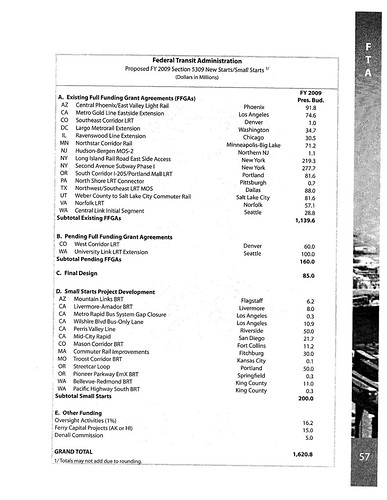
Friday, January 18, 2008
That Sounds Kinda Expensive
It will also allow any further light rail expansion to the east side and create a second river crossing for light rail which would be important should one of the bridges go down in the chance of an earthquake. This is all about expanding the network as Metro Councilor Robert Liberty States.
As Liberty sees it, completing the Portland-to-Milwaukie line will keep the promise of the original system and open up new possibilities, including an extension to Oregon City and east-west connections that do not pass through downtown Portland.As I think further about this and look at the distance, even with the bridge section, 6.5+ miles at a billion dollars seems like a lot of money. It works out to around $150 million per mile (without the bridge section costs). Are they building a trench for it? Is it a subway? Especially since the Yellow Line was under budget and $60 million per mile in 2004. Folks at Portland Transport are commenting on this as well. I wonder what costs so much? Specifically after the Portland folks have gotten good at the track work after the Streetcar and Yellow Line. We really need to reign in these cost issues or new lines will never be built. I believe thats what the opposition wants, as well as our very best friends in Washington DC. Perhaps its time for the rapid streetcar but we'll figure out what is behind the costs soon.
Monday, January 7, 2008
The First Carbon Credits for Rail
I do know that folks in Portland and New York city are looking for ways to capture carbon credits. This might be a better way to start than going after the amount of tailpipe emissions saved by people moving from cars to transit which is often hard to figure out, but should be done eventually. I wonder how hard it would be to retrofit the New York City Subway Cars with this technology?
Saturday, December 15, 2007
Lake Oswego Rapid Streetcar Steps Toward Reality
This would be the first modern application of the Rapid Streetcar idea. It would connect to the City of Lake Oswego to the South Waterfront Streetcar while using the same vehicles.
Saturday, September 8, 2007
Streetcar Watch
There were a lot of stories this week covering the expansion, creation, or history of streetcar lines:
The Tempe Chamber of Commerce is creating a streetcar committee and there were articles in local papers discussing the idea: East Valley/Scottsday Tribune.
Portland has approved funding to keep the Eastside streetcar moving. The Oregonian is following the story.
Little Rock has a streetcar system and is thinking of expanding to the airport. THV has the article. I was struck again by how cheap Little Rock can get it done. Their last expansion was only 7 million a mile and the article makes it seem that they could keep the cost that low again. I've created a map that shows the extension area below and it seems like they would use former railroad ROW. This would make the costs of the line more like railroad costs which is much cheaper.The Portland City Council took a leap of faith Thursday, forced by a deadline to quickly commit $27 million toward building a $147 million extension of the streetcar to the east side.
The project carries some financial risk for the city, but the commissioners agreed that the streetcar could spark the kind of development boom on the east side that has accompanied the westside line through the Pearl, the west end of downtown, the River District and South Waterfront.
"We hope to knit together the east and west sides of the city in ways we would not be able to do otherwise," City Commissioner Sam Adams said.
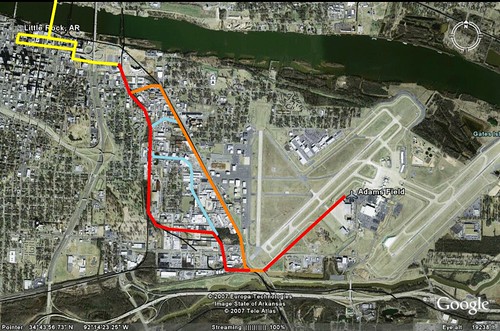
North Little Rock Mayor Patrick Hays says that a planned extension to Heifer International's headquarters would leave only three or four miles to cover to reach the airport. Hays says extending the line to the airport would allow visitors to take the streetcar directly to downtown hotels. Central Arkansas officials are looking into the feasibility of the proposal and a consultant is helping explore the idea. Running the line to the airport would cost an estimated 20 million dollars. Federal grants would cover 80 percent of the cost.
And finally, a series of History Lessons about Sacramento's Streetcar system over at the Sacramento History Blog.
Part 1: Sacramento Streetcar Suburbs
Part 2: Central Street Railway
Part 3: PG&E and It's Predecessors
Part 4: East Sacramento and Elmhurst
Saturday, July 28, 2007
Portland Blogging
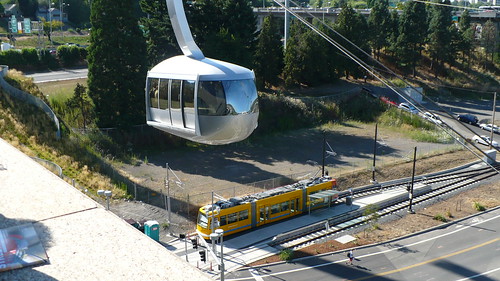
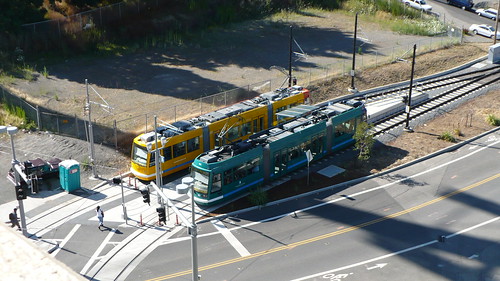
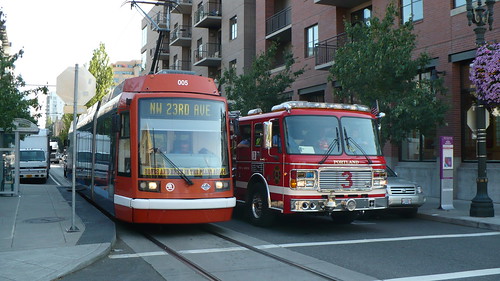
Here is a picture of a firetruck and a streetcar. It was pretty cool and they stayed there for a sec while I took a picture. I'm not sure if it was for me, but if it was, thanks!
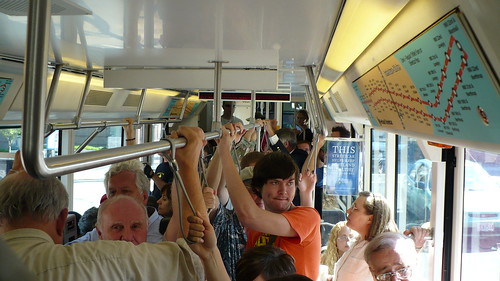
As with the F-Line, it was a crush load on a lot of the cars I saw. In fact it's so full during the afternoon that it's hard for some folks to get on. They need more operating funding so cars can run more often, because every 12 minutes doesn't quite cut it.

We went on the tram and got a testimonial from a doctor that was a skeptic before she started riding it. She said she wondered why they were spending so much money on it, but now she gets it. Instead of 30 minutes during rush hour to get between patient visits in the South Waterfront and OHSU campus, it now takes her 7. It's no surprise that its won her over. It's apparently won over folks who wanted to bike, but didn't like the hill.


Here is traffic to Lake Oswego, better get that rapid streetcar sooner than later.
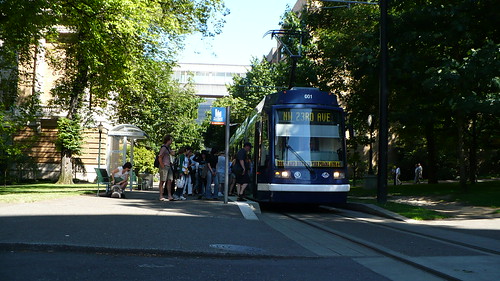
And here is a streetcar in the park for good measure. I'll update later as I upload more photos. Enjoy!!!
Freeway? No. Beerfest!
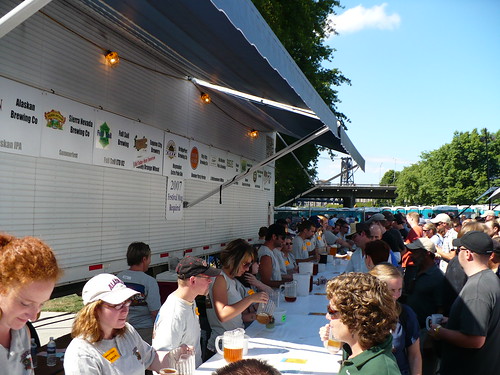
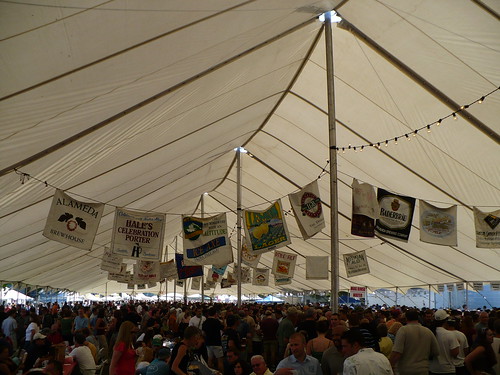
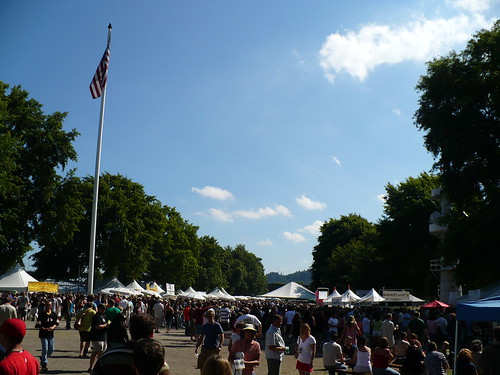
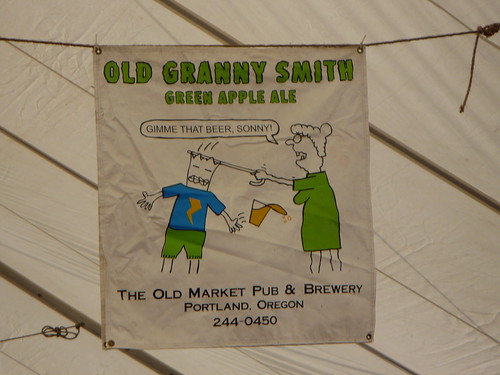
Monday, July 16, 2007
Green Dividend
Four miles per day may not seem like much, but do the math. The Portland metro area has roughly 2 million residents. If Portlanders traveled as much as the typical U.S. metro resident, that would produce 8 million more vehicle miles per day or about 2.9 billion more miles per year. A conservative estimate of the cost of driving is about 40 cents per mile. (At $3 a gallon, 15 cents of this is just the cost of fuel, figured at a fleet average of 20 miles per gallon, which is a generous number for city driving.) All told, the out-of-pocket savings work out to $1.1 billion dollars per year. This works out to about 1.5 percent of all personal income earned in the region in 2005.
This is a good minimum estimate of the aggregate economic benefits—the green dividend—that Portland area residents enjoy as a result of land use planning and related environmental policies. But the benefits don’t stop there. Since Portlanders don’t spend that money on transportation, they have more money to spend on other things. Because so much of what is spent on transportation immediately leaves the state—Oregon makes neither cars nor gasoline—money not spent on transportation gets spent on sectors of the economy that have a much larger local multiplier effect. (Think locally-brewed beer.) According to IRS data, about 73 percent of the retail price of gas (back when it was under $2 a gallon, by the way) and 86 percent of the retail price of cars is the “cost of goods sold,” which immediately leaves the local economy. The $1.1 billion Portlanders don’t spend on car travel translates into $800 million that is not leaving the local region. Because this money gets re-spent in other sectors of the economy, it stimulates local businesses rather than rewarding Exxon or Toyota.Interesting. I wonder how many more cities are going to pick up on this.
Tuesday, July 10, 2007
Rail on Daily Kos
Part 1. Local Rail
Part 2. Rapid Transit
It's an interesting series and spawned a lot of discussion when some bus oriented folks tried to spread talking points from some libertarian think tanks including the Cascade Policy Institute. My favorites included the use of Portland's stat sheet to point out that buses were better than rail in operating hours and also someone arguing on behalf of the Bus Riders Union talking points. One person went so far as to say that each LRV costs $12 million which is ridiculous.
In any event i'm going to re-post some excerpts of my comments below...
...More stats from that ridership chart (Portland, 2004) that matter... Lets look at subsidy per rider, .62 cents for rail to $1.20 for bus, the cost per passenger mile (because we are comparing two different service types) .68 cents for bus versus .29 cents per passenger mile for rail and Max carries 41% of the passenger miles!...
...his argument really revolved around the thought that you could replace a whole system with buses, but then you look at how much they cost per passenger mile and staffing those some 6,000 buses would have broken the operating bank...
...So lets look at the cost of buses versus trains in real costs...just vehicles. In 2007 your transit authority buys two LRVs for six million. It carries 464 passengers per two car consist with one driver. 60 foot articulated buses (nothing longer is legal in the US nor should it be if it is on the same streets as cars) carry 90 passengers max. So to carry the load of the LRT you need about 5 buses. Those 5 buses cost about a million each, each need a driver and have to be replaced in 12 years which means in 24 years you have spent 6 million on two LRVs and 10 million on 10 buses not to mention inflation for the 12 year bus replacement. Then, you have the costs of paving the roads, which in the case of the Orange Line in LA are already messed up (photo proof) But no one ever adds those costs in. Nor do they mention that rail attracts 34-43% more riders...
...Let's also look at energy usage...The Department of Energy Oakridge Lab puts out data every year. The most recent shows rail on top again. 4,318 BTU per passenger mile for bus versus an average of 2,978 BTU per passenger mile of any rail (Amtrak, Rapid Transit and Commuter Rail)...
And so on and so forth. Go ahead and check out Kos. If you aren't a diarist over there you might want to sign up so you can take part in the discussions. However it takes a week I believe before you can post because they don't want folks to just make up names and jump on.
Monday, July 2, 2007
The Rapid Streetcar
Streetcars are cheaper because of their lower infrastructure requirements. Often there is no need to relocat utilities, right of way does not need to be purchased and the stops are smaller and the vehicles more pedestrian oriented. Streetcar stops are also closely spaced if the goal is to be a circulator or short line transport mode. However if a longer distance transit mode that mimics light rail is what you're looking for, but your city is on a budget, the rapid streetcar might be your choice.
Many cities have taken up the mantle of the rapid bus to be their cost effective alternative to light rail, but only do this based on cost, not because its what the citizenry wants. Recent Rapid Bus movements in Oakland, San Francisco, and Charlotte have shown that people really want light rail on a budget but haven't been able to engineer their systems to reduce costs and are therefore left with an inferior transit mode for their stated goals.
But by using streetcars in center lanes with single tracking and passing sidings at stations you can get the same performance as light rail on 10 minute headways. Streetcars aren't single vehicles either. Skoda streetcars have couplers on them as well that would make them multiple car consists. The lighter vehicles are about 66 feet long as opposed to 90 foot LRVs yet you can still get increased passenger capacity and lower infrastructure needs. You can see in the picture below from Skoda.

This fascinating development in value engineering is nothing new and has been rarely used in the United States if at all. A recent extension of the Portland Streetcar to Lake Oswego might be its first test. Literature on the subject has been presented at TRB by Lyndon Henry and has been extensively covered by Light Rail Now! Recent publications including Raise the Hammer in Canada as well as the folks in Kansas City have been looking to this option. This technology and engineering arrangement is a smart way for cities to get rapid transit and build the system they want and can afford, not the system they settle for.
Saturday, June 30, 2007
Building a System: Portland's Legacy
21 years ago nothing was certain. However, the Portland region banded together to decide on their future. In 1986 Portland Tri-Met had 162,500 average weekday boardings, 19,600 on rail and the rest on bus. Fast forward to 2006, we see that 307,200 rides with 99,000 of those rides coming from rail. The May ridership for Portland was 110,000 average weekday boardings. What is important is that this rail push has saved gobs of cash. With a 72 cent required boost from Tri-Met versus a $1.92 for bus, you can see why the investment has paid off. 23% of Portland's operating cost is for rail yet rail makes up 32% of the ridership.
The vision of the original Lutraq plan and the network of rail lines and city centers is being quietly implemented all the time. Expected next week is an FFGA from the federal government for the I-205 Light Rail Line. Planning is underway for the Streetcar to Lake Oswego and Milwaukie Max. This plan shows that when cities put their will and collective mind into doing something it can get done. The expansion of Portland's system can be replicated but it takes time and planning. Hopefully more cities will wake up and realize the cost savings as well as quality of life improvements brought by this way of doing things.
Friday, June 8, 2007
Transit Networks & Highwaymen
Wrong.
The fundamental problem with this is that it's exactly what has caused congestion in the first place, letting everyone believe that they are free to have a piece of road at any time without any congestion. In fact some wish that it was in the constitution. Well where is the logic in that? If we look at nature and floods we see what happens when too much water wants to be all in one place. And so it should come as no surprise if everyone took geology or physical geography some time in high school that this would happen. Yet we keep building one mode of transportation. It's kind of like putting concrete at the bottom of a river to channel it. None of it seeps in to the ground just like cars magically get through traffic. And it seems to me that building all of these transitways for buses just encourages more cars. They might have 2 more people in the but its still a car. It's still VMT and pollution and sprawl.
But if you give people a choice they will take it. But it can't be a half cocked choice. Buses in freeway medians in Houston have shown that they only attract so many riders. I have a theory that it's because they travel in the middle of a freeway. Transit is a pedestrian oriented mode. Freeways are not pedestrian oriented. This is another reason why Houston's 5 transit ways garner about 43,000 riders a day while Portland's Max and Streetcar with 5 lines is over 100,000. Per day. It's why the San Diego Trolley is over 100,000 per day. Network and pedestrian orientation are what drives transit, and more freeways amplifies the inhumanities of single occupancy vehicles. 100,000 people in cars is no small amount of extra concrete for roads and parking spaces.
No one was meant to be that selfish every day of their lives. Yes you can be selfish sometimes. I know I am. I drive to my Gramma's house. She lives in the suburbs where the bus stops running at 3:30pm. It's 3 miles from the BART station and while sometimes I walk, some days i just don't have the extra 2 hours to spare (BART is lame in that they won't let bikes on rush hour trains). But everywhere else I walk or take transit whether it's a bus or a train. Tonight I went to concert by taking the J Church to the 45 Union Bus. Powered by alternative energy from Hydro, $1.50, no parking, no hassle. It's the power of networks and human scale quality transit which it seems some of the highway and HOV people miss.
I saw someone somewhere say that the Blue Line in Chicago which has 12 trains per hour could be replaced with an hov lane and 100 buses per hour and this would be revolutionary. I'm not sure what that person was smoking, but it must be bad stuff.
Monday, April 16, 2007
Cargo Trams
Zurich - Kind of a Good Will Trailer on rails. People drop off disposable items and electronics and it's taken to the recycling center to be disposed of properly. English Translations can be done here.
Amsterdam - City Cargo will use trams and electric vehicles to distribute goods in the city. This is a really promising idea for the United States if we ever rebuild some of our interurban lines. No more big delivery trucks with diesel emissions...
Dresden - Volkswagen built a spur off of the city tram line to transport car parts across the city. The tram line takes 3 trucks off the road per trip. Fascinating Stuff.
A Discussion at Portland Transport about Cargo Trams...and a Swiss Blog is following the trend.
Wednesday, March 21, 2007
Industrial Land and TOD
Given that some industrial lands are still viable as such, pushing out the industry by routing light rail through it can either be good or bad depending on what your goals are for the corridor. Some places such as Oakland might be better served by saving industrial zones to keep jobs and tax base. Of course if there is a station adjacent, what is better for the city and region? Is it that short term tax base or the long term ridership goals of the transit agency? Is it the housing and reduction of VMT through TOD or is it being able to keep vital industry such as shipyards in Oakland's case. Where else are the ships going to go? It's an interesting dichotomy that is only beginning to pop up in planning and land use for these systems.
So how do we figure which industrial uses should be changed over? The Pearl was a railyard that was abandoned and snatched up by developers. It's proximity to downtown made it very valuable after all the details were worked out. Now its the hottest address in the northwest. Minneapolis citizens however are worried that they will run out of industrial land uses unless some of them are protected from rezoning. I want to say that is short sighted and there is plenty of land for industrial uses, the old ones disappeared for a reason, but i'm not sure if i have all the facts to make that claim yet.
Sunday, February 11, 2007
Houston We Have a Problem...
It's easier to read if you click on it. Enjoy!

